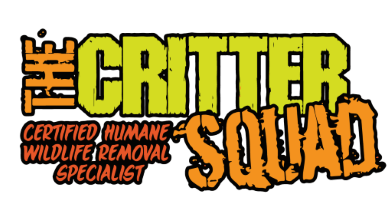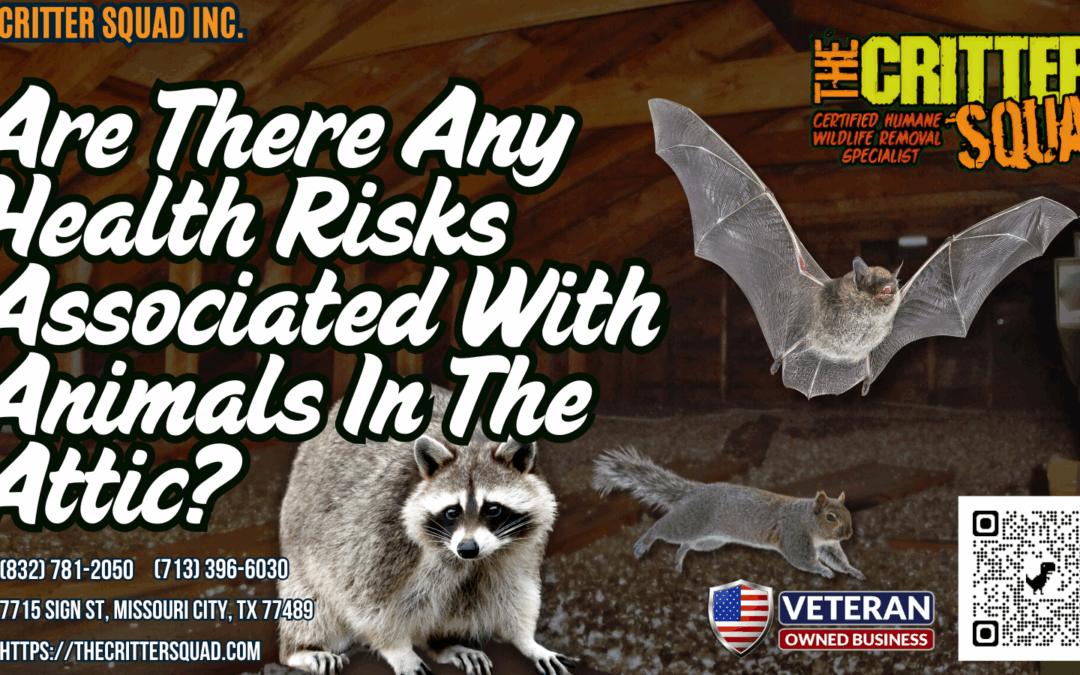Animals in attics pose significant health risks to homeowners. Raccoons can transmit diseases such as rabies and leptospirosis, while rodents may carry hantavirus and salmonella. Their droppings can lead to respiratory issues and compromise indoor air quality. Structural damage may also occur from nesting and gnawing, exacerbating health hazards. Addressing these risks requires prompt action and proper prevention strategies. Understanding the full extent of these concerns can provide valuable insights for maintaining a safe living environment.
Key Article Highlights
- Animals in attics can transmit diseases like rabies and leptospirosis, posing serious health risks to residents.
- Rodent droppings can spread Hantavirus and Salmonella, leading to severe respiratory and gastrointestinal issues.
- Animal feces can introduce harmful mold growth, exacerbating indoor air quality and respiratory health risks.
- Parasites such as fleas and roundworms may be carried by wildlife, leading to further health complications.
- Prompt removal and professional assistance are crucial to mitigate health hazards associated with animal infestations.
Common Animals Found in Attics
When homeowners discover signs of animal intrusion in their attics, they may be unaware of the common species that often take refuge in these hidden spaces. Among them, squirrels are frequent offenders, known for their agile climbing and nesting abilities. Squirrel behavior typically involves looking for sheltered areas to create nests, often leading them to the warmth and safety of attics. These inquisitive creatures can cause significant damage as they gnaw through insulation and wiring in search of nesting materials. Other common intruders include raccoons and bats, each with their unique nesting habits and behaviors. Raccoons, for instance, are known to create nests in attics, where they can cause considerable property damage due to their tendency to rummage through insulation and wiring. Additionally, certain bat species often seek out attics for roosting, which can introduce health risks due to potential exposure to bat droppings. Humane bat removal strategies are crucial for managing bat populations and minimizing risks associated with their presence. Understanding these animals and their tendencies can help homeowners take proactive steps to address and prevent further issues related to attic nesting. Implementing humane squirrel removal strategies is essential to prevent these animals from causing damage and to ensure their safe relocation.
Diseases Carried by Rodents
Rodents, commonly found in attics, pose significant health risks due to the diseases they carry. Understanding rodent behavior is essential for effective disease prevention. Common ailments include hantavirus, leptospirosis, and salmonella, which can affect humans through direct contact or contaminated surfaces. Implementing rat control measures can significantly reduce the likelihood of these diseases spreading.
| Disease | Transmission Method | Symptoms |
|---|---|---|
| Hantavirus | Inhalation of droppings | Fever, muscle aches, fatigue |
| Leptospirosis | Contact with infected water | Headaches, chills, jaundice |
| Salmonella | Ingestion of contaminated food | Diarrhea, fever, abdominal cramps |
Awareness of these diseases and proactive measures can help mitigate risks, ensuring a safer living environment for all. Educating communities on rodent control fosters a healthier atmosphere. Additionally, recognizing rat infestation signs can aid in early detection and prevention of these health risks.
Health Risks From Raccoons
Raccoons pose significant health risks due to their potential to transmit various diseases, including rabies and leptospirosis. In addition to disease transmission, these animals can introduce parasites such as roundworms and fleas, which may additionally endanger human health. Moreover, their nesting habits can lead to structural damage in homes, creating additional concerns for property owners. Implementing humane raccoon trapping methods can help mitigate these health risks while ensuring the safe removal of raccoons from residential areas.
Disease Transmission Risks
Although often viewed as charming wildlife, raccoons pose significant health risks due to their potential to transmit diseases to humans. These animals serve as disease vectors, facilitating the spread of various zoonotic infections, such as raccoon roundworm and leptospirosis. Raccoons may shed parasites and pathogens in their feces, contaminating areas where humans and pets may come into contact. This contamination can lead to serious health implications, particularly for vulnerable populations, including children and immunocompromised individuals. Understanding the risks associated with raccoons in attics is essential for homeowners and communities aiming to protect public health. By addressing these concerns with empathy and proactive measures, individuals can help mitigate the impact of disease transmission and promote a healthier living environment.
Parasite Infestation Concerns
How can homeowners effectively safeguard their living spaces from the hidden dangers of parasitic infestations often associated with wildlife? Raccoons, in particular, can introduce various parasites that threaten health. Understanding their parasite lifecycle is essential for prevention and management.
To mitigate risks, homeowners should consider the following:
- Regular Inspections: Periodically check attics and other potential nesting areas for signs of wildlife activity.
- Proper Waste Management: Secure garbage bins to deter raccoons and minimize attraction to residential areas.
- Professional Treatment Options: Engage pest control specialists to address infestations and employ safe removal strategies.
Structural Damage Implications
The presence of wildlife, particularly raccoons, not only poses risks from parasitic infestations but also raises significant concerns regarding structural damage to homes. Raccoons are known to create extensive damage as they burrow and nest in attics, compromising the structural integrity of roofs and ceilings. Their weight and movements can lead to weakened beams and potential collapse. Additionally, raccoon droppings can contribute to harmful mold growth, exacerbating health risks. Regular attic maintenance is essential to identifying and addressing these issues early. Homeowners should be vigilant about signs of wildlife intrusion and consider professional assistance to mitigate risks. Protecting both health and property requires proactive measures to guarantee a safe living environment for all occupants.
Parasites Associated With Attic Animals
Attic animals, such as raccoons and squirrels, often carry a variety of parasites that can pose significant health risks to humans. Common parasites include fleas, ticks, and mites, which can lead to infestations and subsequent health issues. Understanding these risks is vital for homeowners seeking to protect their living environment and guarantee their family’s well-being.
Common Attic Animal Parasites
While many homeowners may be unaware, the presence of animals in the attic often brings with it a host of parasites that can pose significant health risks. Understanding these common attic animal parasites is vital for effective management.
- Rodent mites: These parasites can infest nests and feed on the host, affecting both animals and humans.
- Fleas: Often introduced by animals, fleas can thrive in attics and lead to infestations throughout the home.
- Ticks: Frequently found on wildlife, ticks can hitch a ride into attics, carrying various diseases.
Awareness of the parasite lifecycle is essential for determining appropriate treatment options. Homeowners should seek professional assistance to safely eliminate these pests and mitigate potential health hazards.
Health Risks From Infestations
Given the potential for infestations, homeowners must recognize the serious health risks posed by parasites associated with attic animals. Common signs of infestation include droppings, gnaw marks, and unusual animal behaviors, which may indicate the presence of rodents or bats. These animals often carry parasites such as fleas, ticks, and mites, which can be transmitted to humans and pets. Exposure to these parasites can lead to allergic reactions, skin irritations, and even more severe health concerns like Lyme disease or hantavirus. Prompt identification and remediation are essential to mitigate these risks. Homeowners are encouraged to seek professional assistance to safely remove infesting animals and address the associated health hazards effectively.
Impact of Droppings on Indoor Air Quality
The presence of animal droppings in an attic can considerably compromise indoor air quality, as these waste materials may harbor harmful pathogens and allergens. The process of dropping decomposition can release airborne allergens, which can pose significant health risks to occupants. It is essential to understand the potential impacts:
- Allergic Reactions: Exposure to droppings can trigger respiratory issues and allergic reactions in sensitive individuals.
- Pathogen Transmission: Contaminants present in droppings can lead to the spread of diseases, impacting overall health.
- Odor and Irritation: The decomposition of droppings can produce unpleasant odors, contributing to an uncomfortable living environment.
Addressing these concerns promptly can help maintain a safe and healthy indoor atmosphere for all residents.
Structural Damage Caused by Animal Infestations
When animals invade an attic, the structural integrity of the home can be severely compromised over time. Their nesting behaviors often lead to insulation damage, which can further degrade energy efficiency. Additionally, sound disturbances created by these animals can indicate more extensive issues, including potential risks of roof damage or weakened support beams. Recognizing these risks early is vital for homeowners seeking to protect their properties.
| Type of Damage | Cause | Consequence |
|---|---|---|
| Insulation Damage | Nesting behaviors | Increased energy costs |
| Roof Damage | Sound disturbances | Water leaks and mold |
| Structural Weakness | Chewing and gnawing | Compromised safety |
| Pest Infestation | Ongoing presence | Health risks for occupants |
Safe Removal and Prevention Strategies
Addressing the risks associated with animal infestations requires effective removal and prevention strategies to safeguard both the home and its occupants. Safe removal of animals is vital, as it minimizes potential health hazards. Professional wildlife control services should be engaged for humane removal. Alongside this, implementing robust prevention strategies can mitigate future risks.
Here are three essential steps:
- Seal Entry Points: Inspect and repair any holes or gaps in roofs, walls, and foundations to prevent access.
- Remove Attractants: Keep food sources, such as pet food and garbage, secured to discourage animals from invading.
- Regular Inspections: Conduct routine checks of the attic and surrounding areas to identify early signs of infestation.
Frequently Asked Questions
Can Pets Contract Diseases From Animals in the Attic?
In a hypothetical scenario, a dog exposed to raccoon droppings in an attic could contract a disease through parasite transmission. This highlights the potential for disease transmission and parasite exposure when pets interact with wildlife remnants.
What Are the Signs of Animal Infestations in Attics?
Signs of animal infestations in attics include the presence of animal droppings, unusual noises, and insulation damage. Homeowners should remain vigilant, as early detection can prevent further damage and guarantee a safer living environment for all.
How Can I Tell if an Animal Is Nesting?
The attic, transformed into a bustling animal metropolis, reveals nesting behaviors through persistent scratching, rustling, and curious animal sounds. Observing these signs can help identify unwelcome furry residents, prompting compassionate action for their safe removal.
Are There Any Legal Restrictions on Removing Wildlife From Attics?
Legal restrictions often govern wildlife removal, emphasizing compliance with wildlife regulations. Professional services advocate for humane removal methods, ensuring the well-being of both the animals and the community, while promoting responsible coexistence with local wildlife.
What Should I Do if I Hear Noises at Night?
Upon hearing nocturnal noises or nighttime disturbances, individuals should investigate calmly, checking for potential wildlife. Consulting a professional is advisable to guarantee safety and proper handling, fostering a respectful approach to both the situation and the animals involved.

